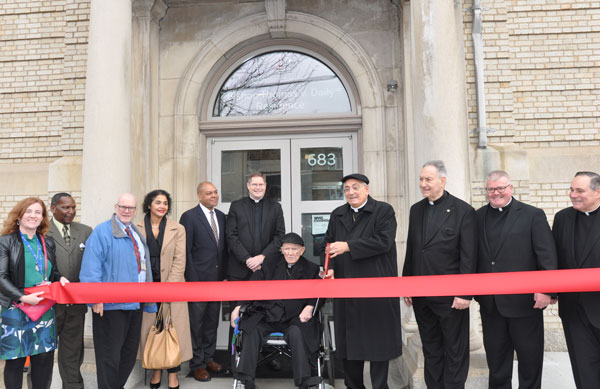
In a rare public appearance, Bishop Emeritus Thomas V. Daily was present for the dedication April 5 of the new Brooklyn Residence named in his honor sponsored by Catholic Charities.
The Bishop Thomas V. Daily Residence for formerly homeless people, is located in the former St. Joseph’s School on Dean St. in Prospect Heights. Since the mid-1980s it has operated as St. Joseph’s Single Room Occupancy Housing.
Bishop Daily, who will be 90 later this year, has been in ill health for the past few years and lives at the Bishop Mugavero Residence for retired priests in Douglaston. He was accompanied to the ceremony by his nephew, Father Vincent Daily of the Archdiocese of Boston, Mass.
Housing Military Veterans
New York State Homes and Community Renewal financed the $10.4 million substantial renovation of the complex, allowing Catholic Charities to preserve 54 apartments for the formerly homeless and create six new apartments, that put a priority on homeless military veterans.
“The Bishop Thomas V. Daily Residence is the last renovation of three single room occupancy buildings, called Caring Communities, which began in 2011,” said Msgr. Alfred LoPinto, president and CEO of Catholic Charities.
“The renovations included new individual apartments, renovated lobby space and new common areas and meeting rooms for a total of 255 formerly homeless individuals.”
The other two residences are the John J. Farrell Residence in Greenpoint, and the Bishop Joseph M. Sullivan Residence in Bedford Stuyvesant, both of which were rededicated in 2015.
The changes at St. Joseph’s allowed the addition of six new units of affordable housing, an update of the building’s systems and the conversion of the existing bedrooms into efficiency apartments.
David Selby, a U.S. Navy veteran and resident of Apt. 201, spoke at the dedication and thanked the staff at the facility for making him feel welcome.
“This is a special place,” said Selby, “I just want to say how happy I am.”
Msgr. LoPinto said that Catholic Charities was honored to name the new project after Bishop Daily, who “dedicated his life to improving the lives of those in need around the world.” He explained that prior to being named a bishop, Bishop Daily had spent five years as a missionary in Peru.
Rich in Faith, Compassion, Charity
Msgr. Ralph Maresca, former secretary to Bishop Daily, also spoke at the ceremony. He recalled Bishop Daily’s “commitment to serving the poor around the diocese. We would be driving and he would see an abandoned building and say, ‘We should buy that building and fix it for the poor.’
“The bishop always said the Church should be poor but rich in faith, compassion and charity.”
Bishop Nicholas DiMarzio, who succeeded Bishop Daily as Bishop of Brooklyn, in 2003, said that “Catholic Charities’ commitment to turning unused church-owned property into housing is one that is shared by many in our Diocese. I am proud of the work that they are doing throughout Brooklyn and Queens and the beautiful residences which they have created.
“The Church teaches us that every person has a basic right to have a place to call home, and Pope John Paul II said that ‘a home is much more than a roof over one’s head. It is a place for building and seeking one’s life.’”
Following the ribbon-cutting, Bishop DiMarzio toured the residence. In Apt. G7, he visited with Niona Scott and commented how warm it was.
“It’s nice and cozy here,” she said.
Extensive Partnerships
Financing for the project was made possible through extensive partnerships among NYS Homes and Community Renewal, U.S. Department of Housing and Urban Development, Richman Housing Resources and Wells Fargo Bank, N.A. Catholic Charities also worked with the U.S. Department of Veterans Affairs, the Mayor’s Office of Veterans Affairs and the NYC Department of Homeless Services.
“We congratulate Catholic Charities Brooklyn and Queens for its commitment to preserve and create new apartment units for the homeless,” said Kevin Hoffman, executive vice president of Richman Housing Resources LLC.
“Bishop Thomas V. Daily Residence is a great example of how public-private partnerships, using federal low income housing tax credit programs, can create and maintain housing for the formerly homeless. We would also like to thank all of our partners, the City and State as well as Wells Fargo.”
